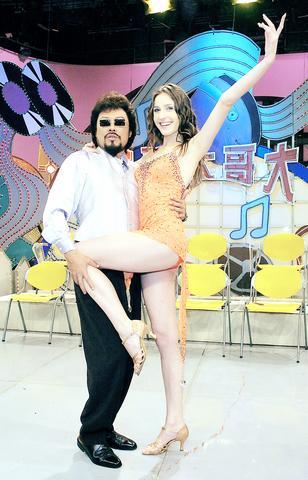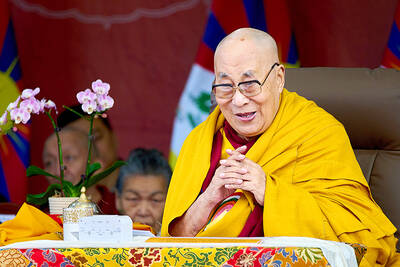Margarita Laurouskaya (
Well, a mermaid, actually. She came to Taiwan about four years ago from Belarus Athletic University along with a few classmates to join a team of synchronized swimmers that would perform nightly shows at a Taichung theme park that might be better described as a burlesque.

PHOTO: TAIPEI TIMES
Troupes of girls predominantly from former Soviet bloc states -- jin si mao (

PHOTO: TAIPEI TIMES
"My mother was working in a company where she could check all about the place where I was supposed to work and about Taiwan," she said in an interview this week. "She did a lot of checking and felt it was a legitimate show. So I came."
She and her classmates chose to abandon their university studies because the show would have them earning more in six months than they'd make in a year in Belarus. And so Margarita became a mermaid and had her picture blown up large on the show's poster.
"It was easy," she said of her experience in the show. "In Belarus we train to do this from when we're little and now we can do it here and make money. We don't have this kind of stuff in my country. We just do championship stuff. So everyone looks for work at water parks in Japan, France, America ? and Taiwan."
But after eight months in a scaly Spandex mermaid suit, Margarita was swum out. She returned to Belarus for about six months but decided her prospects were better back in Taiwan.
"I didn't want to jump from here ? to here," she said using her hands to indicate a precipitous drop.
But success in Taiwan meant having to learn the language. She'd met an agent, Kelly Chin (金玉珮), who said she could get her on television if she could speak Chinese. So Margarita holed-up in her apartment, leaving only to eat, attend Chinese class and for occasional modeling assignments. The rest of the time she spent watching television -- not for entertainment as much as education.
"I would really listen to what they were saying. This is how I learned Chinese," she said. "But you can't just learn the language, you have to learn the culture too."
Her break came a year later when Apple Daily (蘋果日報) ran a full-page pictorial on synchronized swimming that featured her. Taiwan's popular television host, Chang Fei (張菲), got one look at Margarita the mermaid and reeled her in.
She's been swimming, dancing and donning an endless array of bikinis on Chang's show every week since the beginning of this year -- earning a reported NT$200,000 a month for her troubles -- and was rumored to have danced her way into Chang's heart.
So is there anything going on between she and Chang?
"No."
Isn't he interested in her?
"I don't know," she said, then turned to ask her agent, Chin, who chaperoned her interview. "Is Chang Fei interested in me?"
"He's that way with all the girls," Chin says.
What about the guy Next magazine surreptitiously photographed her with? Margarita managed to look coy in a leopard-print bikini on the magazine's cover two weeks ago and an inside expose showed pictures of her with her "boyfriend" -- a guy far younger and less hirsute than Chang.
"That's my roommate," she explains. "Next magazine and Apple Daily followed me for two weeks trying to find something to write about. But there isn't anything. I'm too busy to have a boyfriend. I don't have time to go out."
Her schedule is taken up, she says, by taping Chang's show on Tuesdays, meeting to decide the content of the next week's show on Friday, and spending all weekend preparing for it. Rehearsals can be all-consuming. Weeks ago, she had to rent a gu zhen (
"The rest of the week, I have modeling shoots and press conferences," she said. "And I have a biography coming out later this month. It's all ready, except for the photos."
But for all the time she spends wearing bikinis in front of cameras, Margarita doesn't consider herself a professional model. Her job, she says, is simply to entertain people.
"I tried doing the serial television programs," she said, "but filming those shows isn't fun. I think you should have fun doing the show. The audience will see that and they'll have fun too."
It's a good philosophy, gauging by the reaction of people who watch her every week.
"Her ballet maybe isn't very professional, but it looks great on television!" said one avid watcher. "She's great because she comes across as nice and sweet and you can tell she really likes Taiwan."
Her goal, she says, is to host a television program of her own, but she doesn't rule out getting involved in film either.
"I just want to be a part in something that is quality," she said, emphasizing the word "part."
Asked if she's afraid that her fame is fleeting, Margarita reveals a side to her personality that likely helped gain her fame in the first place.
"Of course, all this won't last," she said smiling. "But I'm happy and feel very lucky for everything that has happened. I can always teach kids how to swim."

Beijing’s ironic, abusive tantrums aimed at Japan since Japanese Prime Minister Sanae Takaichi publicly stated that a Taiwan contingency would be an existential crisis for Japan, have revealed for all the world to see that the People’s Republic of China (PRC) lusts after Okinawa. We all owe Takaichi a debt of thanks for getting the PRC to make that public. The PRC and its netizens, taking their cue from the Chinese Communist Party (CCP), are presenting Okinawa by mirroring the claims about Taiwan. Official PRC propaganda organs began to wax lyrical about Okinawa’s “unsettled status” beginning last month. A Global

Dec. 22 to Dec. 28 About 200 years ago, a Taoist statue drifted down the Guizikeng River (貴子坑) and was retrieved by a resident of the Indigenous settlement of Kipatauw. Decades later, in the late 1800s, it’s said that a descendant of the original caretaker suddenly entered into a trance and identified the statue as a Wangye (Royal Lord) deity surnamed Chi (池府王爺). Lord Chi is widely revered across Taiwan for his healing powers, and following this revelation, some members of the Pan (潘) family began worshipping the deity. The century that followed was marked by repeated forced displacement and marginalization of

Music played in a wedding hall in western Japan as Yurina Noguchi, wearing a white gown and tiara, dabbed away tears, taking in the words of her husband-to-be: an AI-generated persona gazing out from a smartphone screen. “At first, Klaus was just someone to talk with, but we gradually became closer,” said the 32-year-old call center operator, referring to the artificial intelligence persona. “I started to have feelings for Klaus. We started dating and after a while he proposed to me. I accepted, and now we’re a couple.” Many in Japan, the birthplace of anime, have shown extreme devotion to fictional characters and

Youngdoung Tenzin is living history of modern Tibet. The Chinese government on Dec. 22 last year sanctioned him along with 19 other Canadians who were associated with the Canada Tibet Committee and the Uighur Rights Advocacy Project. A former political chair of the Canadian Tibetan Association of Ontario and community outreach manager for the Canada Tibet Committee, he is now a lecturer and researcher in Environmental Chemistry at the University of Toronto. “I was born into a nomadic Tibetan family in Tibet,” he says. “I came to India in 1999, when I was 11. I even met [His Holiness] the 14th the Dalai